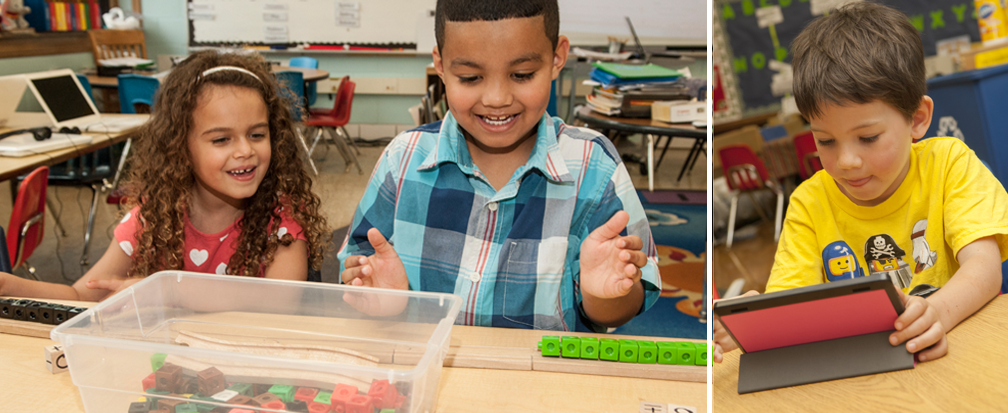Advice From TeachersMultiage Classrooms
Adapting any mathematics curriculum for use in a multiage classroom can be a challenge, but a growing number of teachers report success in adapting Everyday Mathematics for use in a variety of multiage settings. These experienced teachers have developed a number of strategies and recommendations.
Many Everyday Mathematics instructional components are open-ended in nature and are easily adapted to use in a multiage classroom. These components include Math Messages, Math Boxes, games, and Explorations. Most teachers agree, however, that it is best to deliver the Teaching the Lesson section of Everyday Mathematics lessons to students at their appropriate grade level.
There are two commonly used strategies for handling the Teaching the Lesson components in a multiage classroom. The first is to adopt a team-teaching approach, with each teacher working with one grade level for the Teaching the Lesson portion of the lesson, and then completing the other components of the lesson as a multiage group. A second approach is to function as a self-contained classroom. The teacher leads the Teaching the Lesson portion of a lesson with one grade level group, while students in the other grade level are engaged in the Ongoing Learning and Practice component of their lesson. When these activities have been completed, the teacher switches to the other grade level's Teaching the Lesson component, while the first group works on their Teaching the Lesson and Ongoing Learning and Practice activities. The groups are rejoined for lesson activities like games.
At the beginning of each unit a "Multiage Classroom" chart can be found. Companion lessons from previous and future grade levels are given. Please refer to the "Differentiated Instruction" pages which can be found in the Unit Organizer of the Teacher's Lesson Guides for each unit in grades two and three. The charts in the Second Grade Teacher's Lesson Guide list related lessons from Grade 1 and Grade 3. The charts in the Third Grade Teacher's Lesson Guide list related lessons from Grade 2 and Grade 4.
The topic of multiage classrooms needs is actively discussed on the Everyday Mathematics listserv. Below are some questions that have been addressed at length and some answers that teachers have offered. The Everyday Mathematics authors believe you may find "wisdom of practice" helpful.
Advice from Teachers about Multiage Classrooms
Download Advice from Teachers about Multiage ClassroomsHow can I manage or organize Everyday Mathematics in a multiage classroom?
- "Teach a 1st grade lesson while 2nd graders do their Math Boxes and play math games. Then switch the two groups."
- "Do 2 different lessons with the grades. Do the Mental Math together, but then move the different grades into their individual lessons. The younger group will get a lesson first, then the other grade. I had red and green cups on the pod groups. The students would ask their peers for help, but if they still needed assistance, they would turn their red cup to the one on top. This let me know that when I finished with the other group, I needed to check in with those groups first."
- "Do math lessons for the different grade levels at different times."
- "When I started using Everyday Mathematics it was with a 2/3 multiage. I used parent help every day. We scheduled math for an hour and a half each day."
- "I taught Grade 2 parts one and two from the manual while Grade 3 did Part 3 and Math Boxes, and games, etc. Then I flipped to teach Grade 3 while Grade 2 did the extensions etc. I had a parent who was in charge of the group that I was not teaching at the time. She answered questions, supported kids who needed it during math boxes, and played games. What made the whole thing work so well was that each grade level group only had about 10 students. Imagine teaching any lesson in EDM with only 10 students. It goes a lot faster, kids get a lot more individual help and up close instruction. It was a challenge, but it worked. If you have an aide in your classroom she/he could do what I had a parent do."
- "The 1/2 multiage teacher at my school divides the class into 2 grade level groups. One group works on Math Message, Math Boxes, and math games. During this time she is teaching the other group the lesson. Then they switch. It works well for her. I did this myself as well with 1 class (2nd grade) just so I could teach math to a smaller group."
- "Students could trade classes."
How can I organize centers so that they support teaching Everyday Mathematics in a multiage classroom setting?
- "I have two adult centers and two independent centers that my students visit each day."
- "Have a checklist of what centers you want each child to visit. You can delete some or add some based on their skills."



